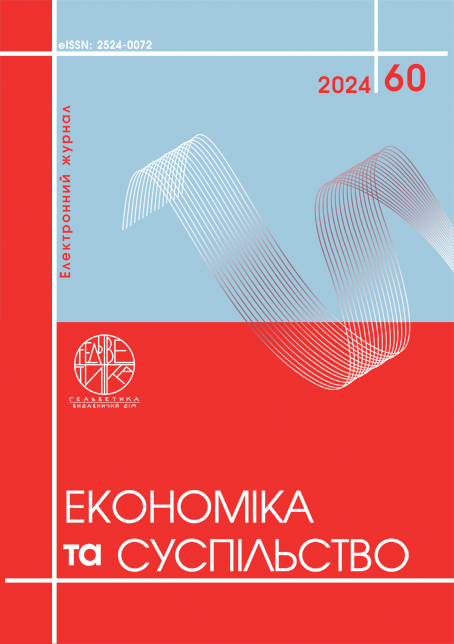APPLICATION OF MERCHANDISING TOOLS AS A MEANS OF STIMULATING PRODUCT SALES IN FOOD RETAIL
Abstract
The aim of the study is to characterize the features of using merchandising tools as a means of stimulating product sales in food retail. It has been proven that the emergence and integration of modern merchandising tools into the retail trade of food products have revolutionized the methods of product distribution and sales. It is determined that merchandising tools are indispensable components of product promotion and sale, being the most crucial link between retailers and consumers. The process of applying merchandising tools in retail, especially in the field of food products sales, is complex and multifaceted, requiring careful planning and execution. In the first stage, retailers analyze the needs and behavior of their customers, using data about previous purchases and preferences to determine which products are most in demand and how best to present them. Based on this information, planograms are developed, which detail where and how products should be placed on shelves to maximize their visibility and attractiveness. Key modern merchandising tools in the system of stimulating product sales are established. The process of applying merchandising tools to stimulate product sales in food retail is presented. It is determined that the implementation of modern merchandising tools in food retail has a positive and significant impact on stimulating product sales. At their essence, these tools encompass a multitude of strategies and technologies designed to present products in the most appealing and accessible way to customers. Through various tools such as digital signage, in-store displays, online banners, and email marketing campaigns, retailers can effectively communicate offers, discounts, and new arrivals to consumers. These promotional efforts are often supported by data-driven insights, allowing retailers to tailor their messages and offers to specific customer segments, thereby enhancing the relevance and effectiveness of their marketing endeavors. As retail continues to evolve, particularly with the integration of digital technologies, the role of merchandising tools becomes increasingly significant in creating a differentiated and memorable shopping experience that resonates with consumers in a crowded market.
References
Струк, Н., & Капраль, О. Маркетингова стратегія підприємства: суть і процес вибору. Економіка та суспільство, № (55). 2023. DOI: https://doi.org/10.32782/2524-0072/2023-55-75
Bondarenko, A.F., Zakharkina, L.S., Syhyda, L.O., Saher, L.Y. The economic and marketing attractiveness of countries: Measurement and positioning in terms of economic security. International Journal of Sustainable Development and Planning, Vol. 15, No. 4, 2020, pp. 439–449
Amajid, G., El Wazani, Y., Elwazani, Y. Territorial marketing and its effects on Development, approach from the literature. Revue Marocaine de Recherche en Management et Marketing, 13, 2016: 111-129.
Bilan, Y., Lyeonov, S., Lyulyov, O., Pimonenko, T. Brand management and macroeconomic stability of the country. Polish Journal of Management Studies, 19(2), 2019: рр.61–74.
Adnan, A.R., Widowati, R., Nuryakin. Customer loyalty in green marketing research: A systematic review. International Journal of Environmental Impacts, Vol. 6, No. 4, 2023, pp. 207–214
Kolisnychenko, T., Sefikhanova, K., Kapral, O., Karpenko, V., Sylkin, O. Development of an algorithm for Internet marketing strategy implementation: A case study in the EU hotel and restaurant sector. Ingénierie des Systèmes d’Information, Vol. 28, No. 6, 2023, pp. 1549–1556
Fátima, F., Gonçalves, A., Sandrina, T. Information technology adoption on digital marketing: A literature review. Informatics. 8(4), 2021: 74.
Hoffman, D.L., Moreau, C.P., Stremersch, S., Wedel, M. The rise of new technologies in marketing: A framework and outlook. Journal of Marketing, 86(1), 2022: 1–6.
Kopytko, O., Lagodiienko, V., Falovych, V., Tchon, L., Dovhun, O., Litvynenko, M. Marketing communications as a factor of sustainable development. International Journal of Engineering and Advanced Technology, 8(6), 2019: 3305-3309.
Shanmugam, G., Rajendran, D., Thanarajan, T., Murugaraj, S.S., Rajendran, S. Artificial intelligence as a catalyst in digital marketing: Enhancing profitability and market potential. Ingénierie des Systèmes d’Information, Vol. 28, No. 6, 2023, pp. 1627–1636
Struk, N., & Kapral, O. (2023). Marketynhova stratehiya pidpryyemstva: sutʹ i protses vyboru [Marketing strategy of the enterprise: essence and selection process]. Ekonomika ta suspilʹstvo - Economy and Society, vol.(55). DOI: https://doi.org/10.32782/2524-0072/2023-55-75 [in Ukraine]
Bondarenko, A.F., Zakharkina, L.S., Syhyda, L.O., Saher, L.Y. (2020). The economic and marketing attractiveness of countries: Measurement and positioning in terms of economic security. International Journal of Sustainable Development and Planning, Vol. 15, No. 4, pp. 439–449 [in English]
Amajid, G., El Wazani, Y., Elwazani, Y. (2016). Territorial marketing and its effects on Development, approach from the literature. Revue Marocaine de Recherche en Management et Marketing, 13: pp.111-129. [in English]
Bilan, Y., Lyeonov, S., Lyulyov, O., Pimonenko, T. (2019). Brand management and macroeconomic stability of the country. Polish Journal of Management Studies, vol.19(2): pp.61–74. [in English]
Adnan, A.R., Widowati, R., Nuryakin. (2023). Customer loyalty in green marketing research: A systematic review. International Journal of Environmental Impacts, Vol. 6, No. 4, pp. 207–214 [in English]
Kolisnychenko, T., Sefikhanova, K., Kapral, O., Karpenko, V., Sylkin, O. (2023). Development of an algorithm for Internet marketing strategy implementation: A case study in the EU hotel and restaurant sector. Ingénierie des Systèmes d’Information, Vol. 28, No. 6, pp. 1549¬1556 [in English]
Fátima, F., Gonçalves, A., Sandrina, T. (2021). Information technology adoption on digital marketing: A literature review. Informatics. Vol.8(4): P.74. [in English]
Hoffman, D.L., Moreau, C.P., Stremersch, S., Wedel, M. (2022). The rise of new technologies in marketing: A framework and outlook. Journal of Marketing, vol.86(1): pp.1–6. [in English]
Kopytko, O., Lagodiienko, V., Falovych, V., Tchon, L., Dovhun, O., Litvynenko, M. (2019). Marketing communications as a factor of sustainable development. International Journal of Engineering and Advanced Technology, vol.8(6): pp.3305–3309. [in English]
Shanmugam, G., Rajendran, D., Thanarajan, T., Murugaraj, S.S., Rajendran, S. (2023). Artificial intelligence as a catalyst in digital marketing: Enhancing profitability and market potential. Ingénierie des Systèmes d’Information, Vol. 28, No. 6, pp. 1627–1636 [in English]

This work is licensed under a Creative Commons Attribution 4.0 International License.


